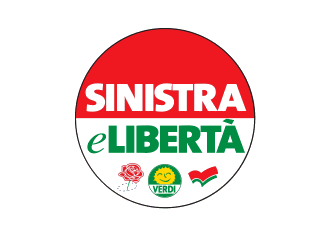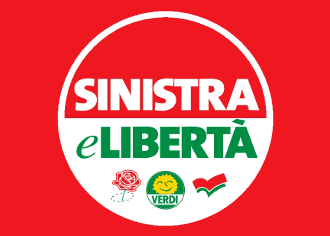
 images by Andrea Pollett, 20 March 2010, 28 April 2009
images by Andrea Pollett, 20 March 2010, 28 April 2009
Last modified: 2013-01-26 by rob raeside
Keywords: left and liberty | sinistra e libertà |
Links: FOTW homepage |
search |
disclaimer and copyright |
write us |
mirrors

 images by Andrea Pollett, 20 March 2010, 28 April 2009
images by Andrea Pollett, 20 March 2010, 28 April 2009
See also:
Sinistra e Libertà (Left and Liberty) - This is a new coalition,
founded in March 2006, which includes:
- Sinistra Democratica (Democratic Left), i.e. the faction that broke off from
the Left Democrats in 2007, judging their policy too centre-wise;
- Movimento per la Sinistra (Movement for the Left), i.e. the faction that broke
off from the Communist Refoundation Party in early 2009, judging their policy
too radically left-wise;
-
Partito Socialista Italiano (Socialist Party);
-
Federazione dei Verdi (Green Federation);
- Unire La Sinistra (Unite The Left), a small faction that broke off the Party
of Italian Communists in 2008, judging their policy too radically left-wise.
The coalition will take part in the European elections in June 2009. The flag is
red, with the round logo in central position. The upper half of the logo is red,
marked by a thick white outline, and bears the word "SINISTRA" in white. The
bottom half is white, bearing the words "e LIBERT└" in green; below the words
are three small symbols: (from the left) a red rose with twelve stars around its
stem (i.e. the symbol of the Socialist group in the European Parliament), a
green circle with a smiling sun and a white band saying "VERDI" (i.e. the logo
of the Green Federation) and a red chevron with a white/green outline (i.e. the
symbol of the European United Left / Nordic Green Left group in the European
Parliament).
The lettering is in uppercase, except the word "e", which is in lowercase and in
italics style.
The first time I saw this flag, on the day the coalition leaders held their
first public speech (march 21, 2009), the background colour was white. But ever
since, I only saw the red version of the flag, a colour that appears much more
consistent with the political orientation of the coalition. I don't know whether
the dual version was deliberately planned, or whether the chosen colour was
initially white, and was changed into red at a later stage. In either case, I
guess that sympathizers may dislike the first colour; this would give reason for
the early discontinuation of the white flag.
A picture of the white flag held by the party leaders can be seen here.
In this version, the size of the logo appears slightly smaller and surrounded by
a thin black outline.
I am presently unable to tell whether the white flag can be officially
considered a pattern still in use or a very short-living obsolete variant.
Andrea Pollett, 28 April 2009
Here is a photograph
by me, taken 23 May 2009, at Verona.
Marcus Schm÷ger, 1 June 2009